Want more customers from YouTube? Wondering what types of YouTube videos you need to make?
In this article, you'll discover different types of videos to create for a YouTube sales funnel.

How to Use Video in a YouTube Sales Funnel
Building a YouTube marketing funnel means understanding what types of videos to produce, and there's no better framework than the content marketing funnel.
By understanding the stages of the content marketing funnel, you'll clearly see how powerful it is and how your videos will appeal to buyers at each stage. Let's take a look at what the funnel includes along with types of YouTube videos you can produce at each stage.
Create Awareness at the Top of the Funnel
The top of the funnel is where you help buyers identify the challenges they face. This stage is important because buyers aren't yet aware of a solution and won't know why yours is the best choice.
Put another way, they won't know that your solution is ideal if they don't fully understand what challenges they face. This stage is all about educating them about the problem. Here are some YouTube videos you can create to do that.
Educational Videos
Buyers lack information at the beginning of their journey to findi a solution. This is where becoming their guide can pay off. And becoming a guide means creating videos that answer quick questions, as in the Watermelon Media video below. The video explains what content marketing is in a short, animated, easy-to-understand way.
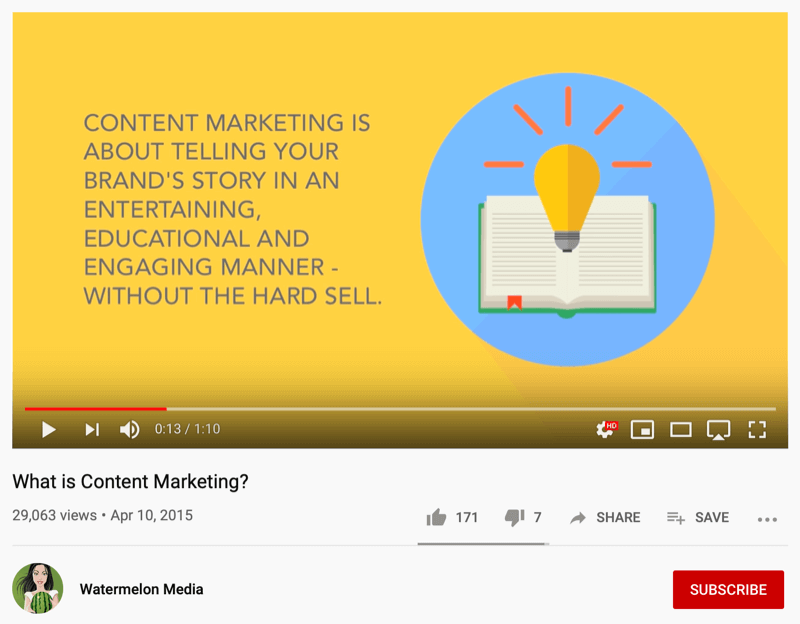
Explainer Videos
Explainer videos are a staple in digital marketing. They discuss complex concepts in simple language, giving viewers a better understanding of what your solution offers and how it works.
Using visually interesting graphics and animations, this Zendesk video explains how Zendesk Guide can help businesses improve customer service by putting all of their institutional knowledge of customer issues to work for them:
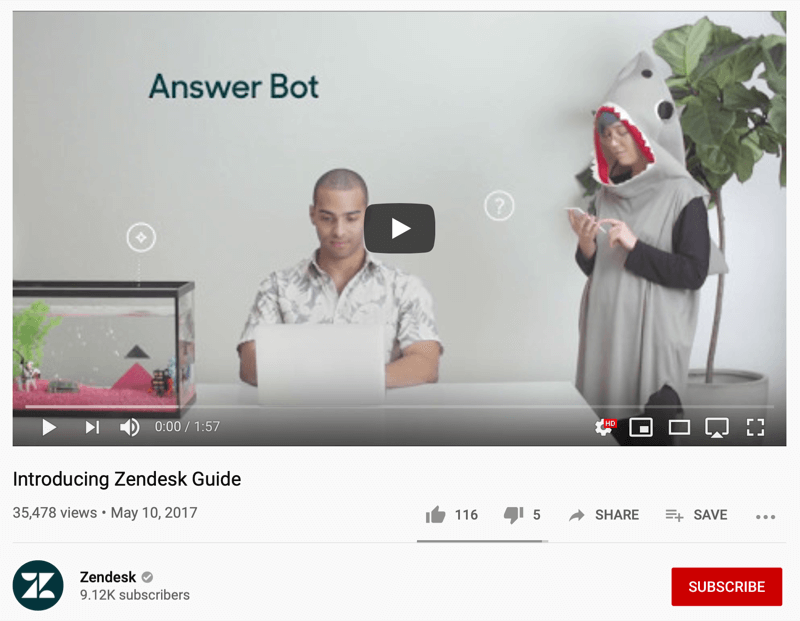
Short Video Ads Identifying Problems
Short ads can be highly effective when executed well. Take this “Backing Jody Pardue” ad from QuickBooks, for example. In the video, actor Danny DeVito dispenses advice to Jody about how switching to QuickBooks can save her time and energy running her personal trainer business. The ad lasts 30 seconds but hooks you from the start. It has more than 960,000 views on YouTube and has also run on TV.

Drive Consideration at the Middle of the Funnel
The second stage of the YouTube marketing funnel is where you begin to introduce your product as a solution to the challenges identified at the top of the funnel. Here you want to focus on specifics, including how your product works, why it works in a certain way, and even the alternatives available and why they aren't the ideal solution.
Get World-Class Marketing Training — All Year Long!
Are you facing doubt, uncertainty, or overwhelm? The Social Media Marketing Society can help.
Each month, you’ll receive training from trusted marketing experts, covering everything from AI to organic social marketing. When you join, you’ll also get immediate access to:
- A library of 100+ marketing trainings
- A community of like-minded marketers
- Monthly online community meetups
- Relevant news and trends updates
Product Intro Videos
Videos that introduce your product and how it works are critical for buyers. The goal of this HubSpot video is to show how easy it is to use HubSpot CRM. If you're a potential buyer who's strapped for time, watching a 60-second rundown the CRM's capabilities is a quick win.

Tutorials
Tutorials provide prospects with a more in-depth experience of your offering. This type of video is ideal for prospects who are considering their options and want to take a closer look at what your product can really do for them.
Pixelmator created this 3.5-minute video to peel back the curtain on what buyers need to know about getting started with Pixelmator Pro. The video teaches beginners how to use the image-editing software.
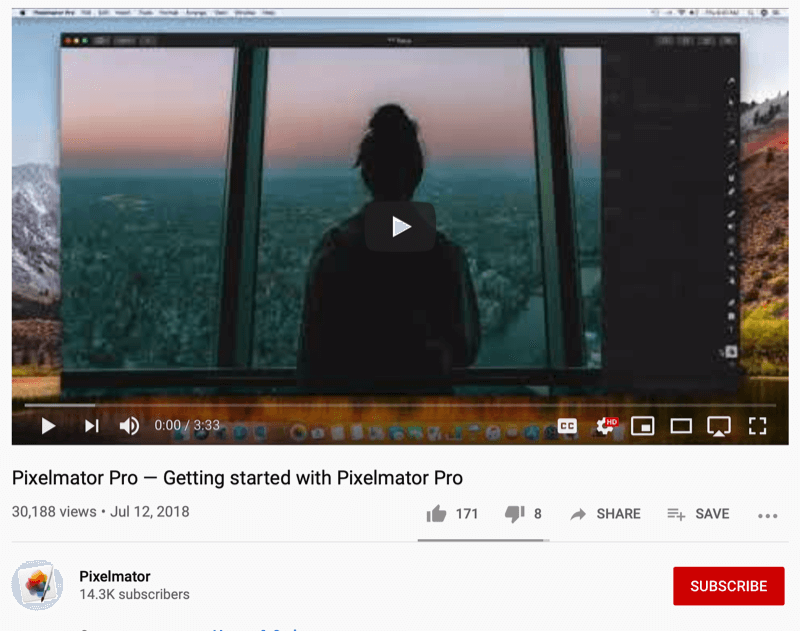
Influence Decision-Making at the Bottom of the Funnel
The bottom of your funnel is where you move in for the sale, so focus on YouTube content that will help convert leads into customers. This often involves reinforcing ideas shared at the middle of the funnel.
Demo Videos
Online marketer Pat Flynn has attracted a large online following over the years. He is also a ConvertKit customer, pairing up with the company to host this 27-minute demo and tutorial. In the video, Flynn shares how easy it is to use ConvertKit's email marketing software.

Customer Testimonial Videos
According to social proof theory, a person who doesn't know the proper behavior for a certain situation will imitate the behavior of others and look for guidance for their actions. Using video testimonials at the bottom of your funnel is a great way to inject some social proof into your buyer's journey.
But don't just scratch the surface or be vague in your video. Give specifics and create a story that's worth watching, especially for buyers looking to be convinced that yours is indeed the right solution.
In this testimonial video from Dropbox, Australian construction company Built explains how Dropbox Business has helped them streamline operations.

Improve Retention By Onboarding New Customers
While the content marketing funnel generally includes three stages, savvy marketers will also focus on what happens after leads become customers. YouTube video can also be used as a tool for onboarding new customers, helping them quickly become familiar with your product. One of the potential benefits of doing this is a longer customer lifetime for referrals.
Agile CRM walks new customers through the steps for creating landing pages with their software. In the video below, customers get a walkthrough of each element of the landing page builder and how it can be used to quickly create landing pages.

Mention, a media monitoring solutions provider, also does a great job of setting their clients up for success. They offer a collection of free YouTube tutorials on how to navigate and use their software.
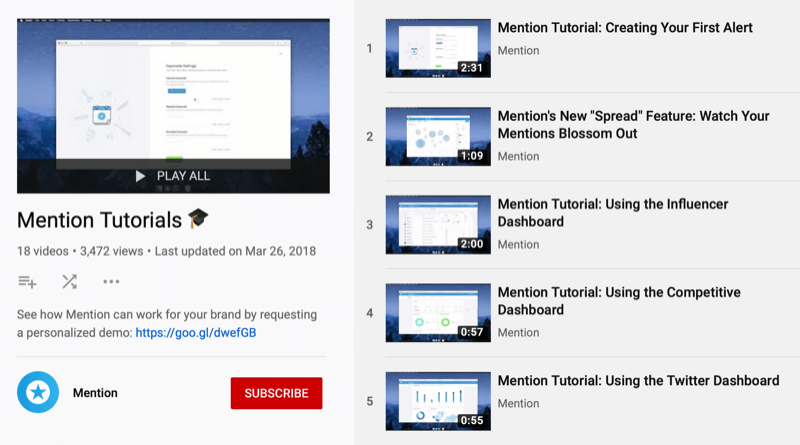
Now that you're familiar with the different types of videos to create for a YouTube sales funnel, here's how to get started developing content for your channel.
#1: Outline a Video Content Plan for Your YouTube Marketing Funnel
The first step in planning your content is to identify where your business is in its YouTube lifecycle. Take stock of what YouTube video content you currently have and how it's performing. Knowing what you're working with will help you make the right decisions about where to spend your time and budget.
To visualize this, if your business is just getting started on YouTube or has only a handful of videos, developing videos for the middle and bottom of the funnel won't be the best use of your budget or time.
Why? New channels need to build audiences and the best way to do so is by focusing on awareness. Building awareness on YouTube means going after long-tail keywords and creating content that can be shared and viewed as much as possible.
Over time, as your channel grows, you can produce content for the middle and bottom of your funnel. This content will then be relevant to your problem-aware audience.
If your YouTube channel has been around for a while, figure out how much content you have for each stage of your funnel and how those videos are performing. If you have a number of awareness-building videos but no how-tos or tutorials on your product, there's a good chance that the lack of these kinds of videos is influencing how many leads you're generating and sales you're making.
Plan a Content Mix for the Different Stages of Your Funnel
Once you've established what you're working with, it's time to plan your content.
As a (very loose) rule of thumb, try this content mix for your YouTube video funnel:
- Top-of-the-funnel content: 40%
- Middle-of-the-funnel content: 40%
- Bottom-of-the-funnel content: 20%
Why the 40:40:20 split? Consider the shape of a content marketing funnel. It's broader at the top and narrower at the bottom. Its shape signifies that fewer buyers make it all the way through the funnel.
In Jeremy Miller's book Sticky Branding, he introduced the idea that only 3% of the top 10% of your buyers are active and ready to spend money. The other 7% intend to reconsider and become active buyers at some point.
Miller goes on to explain that the remaining 90% consists of buyers who have a need but aren't ready to act (30%), don't have a need (30%), or simply aren't interested in your company (30%).

Discover Proven Marketing Strategies and Tips
Want to go even deeper with your marketing? Check out the Social Media Marketing Podcast! Publishing weekly since 2012, the Social Media Marketing Podcast helps you navigate the constantly changing marketing jungle, with expert interviews from marketing pros.
But don’t let the name fool you. This show is about a lot more than just social media marketing. With over 600 episodes and millions of downloads each year, this show has been a trusted source for marketers for well over a decade.
It's easy to see why you should be spending more time creating videos at the top and middle of the funnel. Producing the right amount of content at these stages will help introduce your business to buyers who aren't ready to commit yet.
When they are ready to make a purchase, there's a greater probability that they will turn to a brand that's helped them identify their challenges and educated them on how best to solve their problems.
Create a YouTube Content Calendar
Planning your video content is like planning any other content marketing initiative: It must be strategic and well-documented. Creating a content calendar for your YouTube videos will eliminate any confusion, lack of direction, or anxiety associated with producing and publishing videos. Then use your calendar to produce the videos you need for your marketing funnel.
#2: Produce Videos Optimized to Increase YouTube Watch Time
YouTube is the second-largest search engine in the world, and like all search engines, SEO is an important element for generating views for videos.
But what should you consider if you want to rank and get more views on YouTube? For starters, use keywords in your video title and description. But don't stuff your keywords; instead, get creative with your titles and work your keywords in so they're eye-catching and relevant.
And while keyword optimization certainly matters, watch time matters more. Watch time is the amount of time someone spends watching a video. As an aggregate of all video views, this metric is considered one of the most heavily weighted.
Why does watch time matter? YouTube, like Google, wants to serve up the most relevant content to users. The longer someone watches a video, the more proof the video is relevant. Briggsby's YouTube SEO Ranking Factor Study found that the more watch time a video receives, the higher it ranks on YouTube.
Here are some ways you can optimize your videos to increase watch time.
Lead With Your Hook
There's a good chance that you'll be entering a market filled with competitors. Your YouTube video isn't going to be the only one covering a specific topic so you'll need to present your take more compellingly.
Resist the urge to lead with flashy intros. Instead, give viewers concrete information. Lay out how you're going to provide value throughout your video to show them that watching it will be worth their time.
Use Pattern Interrupts
Pattern interrupts are more commonly used in neuro-linguistic programming to alter psychological states. The process of using a pattern interrupt in video involves introducing a new idea that's completely different from the one being discussed, making the viewer shift their attention.
Pattern interrupts are valuable because they prevent viewers from switching off, especially when topics get complex. In the video below, Sonos uses sound effects, animated text, and constantly switching camera angles to hold viewers' attention.
Pattern interrupts have been proven to be very successful. Buffer used them in their YouTube videos and saw a 59% increase in audience size in just 30 days.
Introduce Key Graphics
Graphics are a great way to address ideas introduced in your videos. They improve comprehension and recall, and pattern interrupts.
#3: Drive Traffic to Your YouTube Videos
Generating traffic for your YouTube channel isn't as challenging as you might think. With a little work, you can start feeding the top of your funnel with viewers who are interested in your content.
To do that, you need to change how you think about traffic. It's out there. All you need to do is figure out where your audience is and get in front of them with an offer to watch your content.
There are tons of places to look to find traffic. A simple way to start is to head over to Google and research terms related to your video. Search for terms your audience is using to find answers to their questions. Look for forums, Facebook pages, online magazines, websites, podcasts, and more.
Also cross-promote your videos on your other social media channels. If you have an Instagram following, use Instagram Stories to market your latest video. If you have a Facebook page, create a post with a link to your newest video.
#4: Generate Leads and Sales From YouTube
YouTube ads are a great way to target audiences. Users are typically looking for information to solve a specific problem, and by targeting the right demographics, you'll be able to reach your audience with a short, impactful ad.
Note that while you can run ads to a new audience, another powerful way to generate leads is to retarget people who have visited pages on your website. This approach is more strategic and allows you to serve videos that are relevant to what visitors have seen on your site, making their journey to purchase more coherent and easier to follow.
One of the oldest and most effective ways to generate leads is with lead magnets. Introduce yours as an offer in your YouTube video and send viewers to a landing page.
If your sales process is simple, sending a viewer to a sales or product page is straightforward. You can either create a call to action (CTA) with the link or direct them to the description section to find the link.
4 Places to Deliver CTAs in Your YouTube Videos
Delivering clear CTAs is critical to building your YouTube marketing funnel. Without a clear CTA in your video, your buyers won't know what to do to take the next step in the journey and move down your marketing funnel.
YouTube Cards
YouTube introduced cards to allow video creators to engage users on mobile and desktop. You can use YouTube cards to suggest content (videos, playlists, channels, or a link to a website), share a poll, and request donations at specific points during your video. Cards are perfect for drawing viewers' attention and directing them toward an offer.

Landing Links in the Description
Content downloads work well to help generate leads. In the example below, Wholesale Ted makes viewers an offer to download their free eBook. Note how clear the CTA is. Viewers are directed to the description section to download the guide.
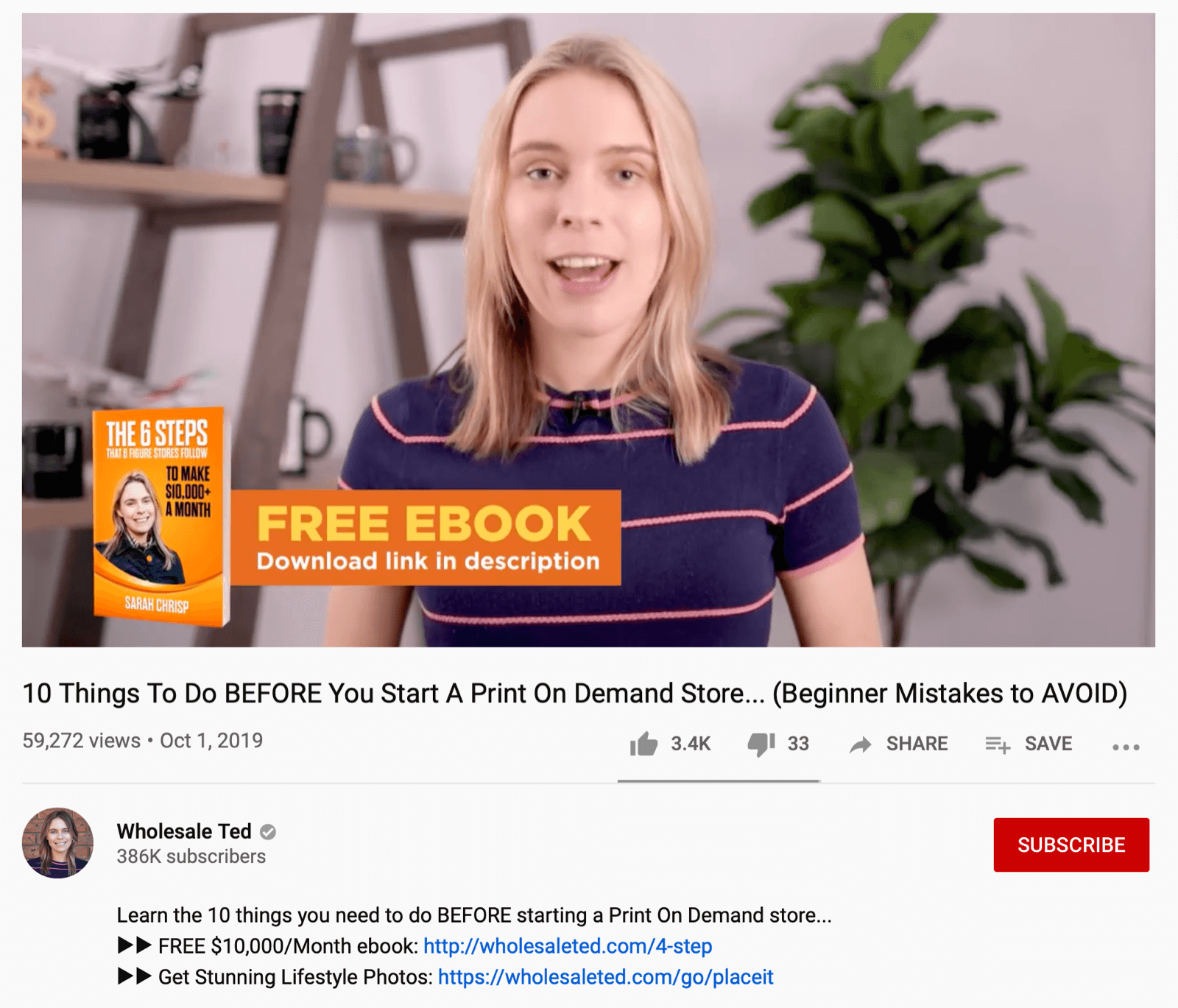
Descriptions are an ideal place to include links to content that's on YouTube or an external site (like a landing page or social media account).
Overlays
Overlays, like other CTAs, are clickable. They appear in the bottom left of your video. They're a great way to entice click-throughs because of their design. Overlays also allow you to add UTMs, making it easier to track the effectiveness of your CTA.
Endscreens
You can offer viewers the CTA at the end of your video with endscreens, as shown below. This is an older, more common approach to asking viewers to subscribe to your channel, but it still affords you the option of placing a clear next step directly in front of your audience.
Suggesting other videos to watch works well for content that's related to your last video. What's more, you can decide which videos show up as suggested content, making it easier to help your buyers move through your funnel.
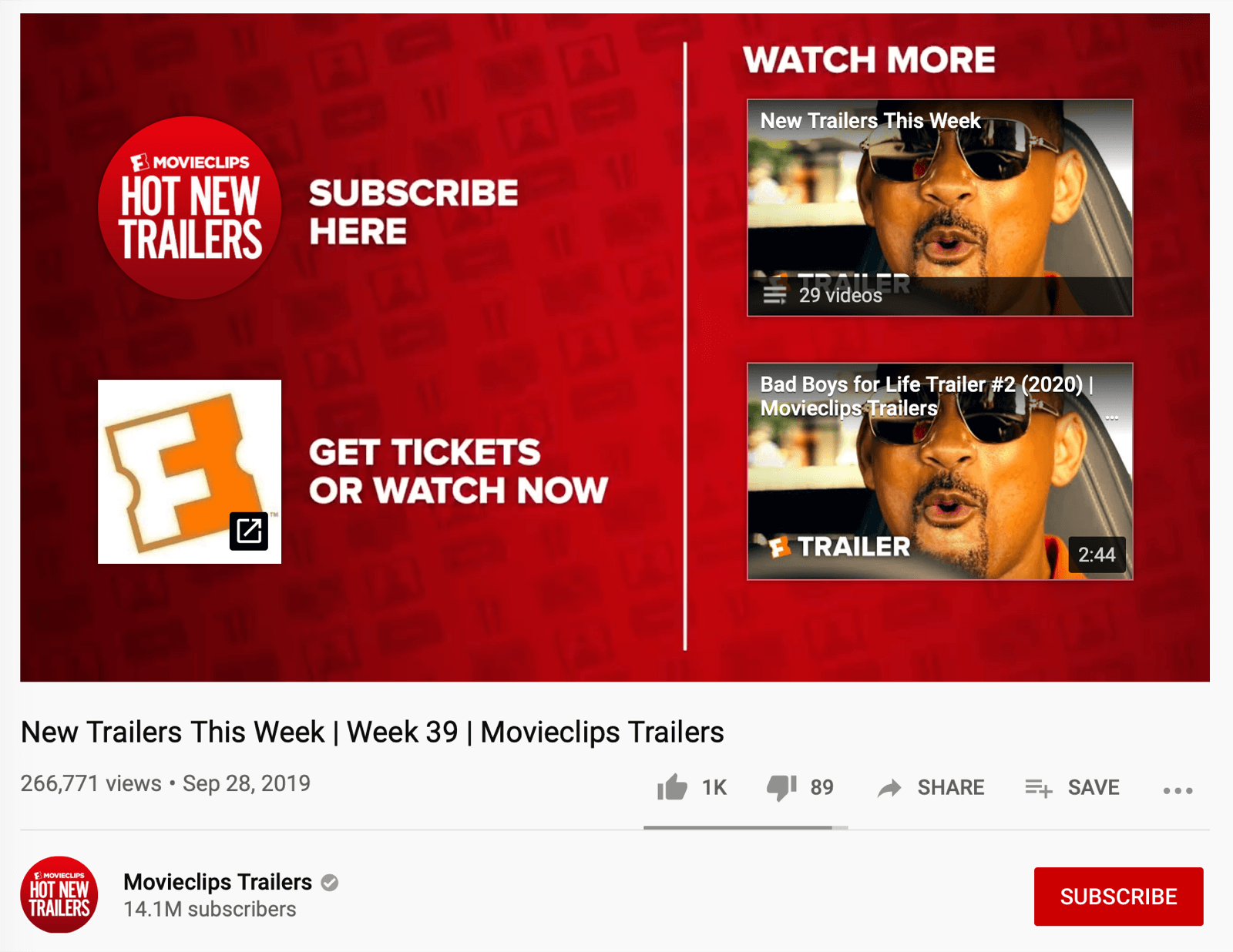
Conclusion
If you've been creating YouTube videos but your audience doesn't seem to be interested in converting, you're likely wondering what you need to do to convert viewers.
The most effective strategy for converting YouTube viewers into paying customers will depend on the industry you're in and the products and services you offer. A B2B technology company with a complex SaaS offering, to illustrate, isn't looking for the sale immediately after a brand-awareness video. Instead, SaaS marketers know that their sales cycle is slightly longer, with more important engagements that must be made to win the customer over.
A clothing eCommerce store, on the other hand, will have a simpler conversion process. It could start with a video of an article of clothing or a pair of shoes followed by a CTA to make a purchase at the end of the video.
By following the steps outlined above, you can build a high-converting YouTube marketing funnel that's tailored to your business. If you create your funnel the right way and produce quality videos, you'll set your brand up for success, making it easier to attract and convert more buyers using video.
What do you think? What types of video will you include in your YouTube sales funnel? Share your thoughts in the comments below.
More articles on YouTube marketing:
- Find out how to grow your YouTube channel with a video series.
- Discover six tools to help improve your YouTube video exposure.
- Learn how to set up Google Analytics to analyze and assess the effectiveness of your YouTube marketing.
Attention Agency Owners, Brand Marketers, and Consultants

Introducing the Marketing Agency Show–our newest podcast designed to explore the struggles of agency marketers.
Join show host and agency owner, Brooke Sellas, as she interviews agency marketers and digs deep into their biggest challenges. Explore topics like navigating rough economic times, leveraging AI, service diversification, client acquisition, and much more.
Just pull up your favorite podcast app, search for Marketing Agency Show and start listening. Or click the button below for more information.

